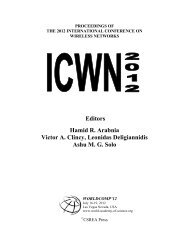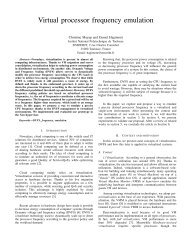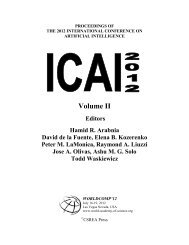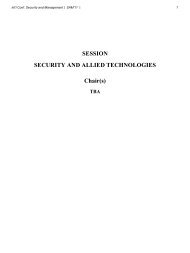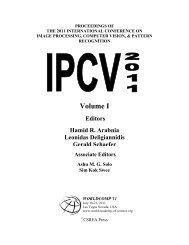SESSION NOVEL ALGORIHMS AND APPLICATIONS + ...
SESSION NOVEL ALGORIHMS AND APPLICATIONS + ...
SESSION NOVEL ALGORIHMS AND APPLICATIONS + ...
Create successful ePaper yourself
Turn your PDF publications into a flip-book with our unique Google optimized e-Paper software.
36 Int'l Conf. Foundations of Computer Science | FCS'11 |<br />
Figure 3: A moderately challenging puzzle that can be solved with the<br />
Test Cell algorithm.<br />
2.3 Extension to the Test Cell Algorithm<br />
For a guaranteed solution to more difficult Sudoku<br />
puzzles, the Test Cell algorithm adopts an easy extension<br />
with the use of “BackPuzzle” puzzle configurations. In this<br />
arrangement, Test Cells are further classified as immediate<br />
or non-immediate (NI) Test Cells. Immediate Test Cells are<br />
the commonest in puzzles falling in the typical Easy,<br />
Medium, and Hard categories while non-immediate Test<br />
Cells begin to occur in the more difficult puzzle categories.<br />
An immediate Test Cell is one for which insertion of the<br />
alpha or beta number leads to a Dead End upon performing<br />
the Easy Cell method for the first chosen insertion, and a<br />
normal progress (i.e. NOT Dead End) for the other. This is<br />
illustrated in Figure 4 and Figure 5 where A and B<br />
represent alpha and beta numbers respectively. It is<br />
instructive to note that the Test Cell algorithm without the<br />
extension assumes only immediate Test Cells for a puzzle.<br />
Figure 4: An immediate Test Cell with the alpha number correct and the<br />
beta number wrong, after performing the Easy Cell method<br />
Figure 5: An immediate Test Cell with the alpha number wrong and the<br />
beta number correct, after performing the Easy Cell method<br />
A non-immediate (NI) Test Cell on the other hand is one<br />
for which either insertion of the alpha or beta number leads<br />
to a normal progress upon performing the Easy Cell<br />
method, such that either insertion appears to be correct.<br />
According to the Test Cell theory however, one of these<br />
insertions will eventually produce a Dead End at a later<br />
stage if you proceed solving the puzzle with it while the<br />
other will not, thereby remaining consistent with the Test<br />
Cell definition. This is illustrated in Figure 6 and Figure 7.<br />
The BackPuzzle configuration mentioned earlier is the<br />
puzzle configuration at the point when a non-immediate<br />
Test Cell is found to exist in the puzzle being solved.<br />
BackPuzzle configurations are useful because if both alpha<br />
and beta insertions of a Test Cell lead to a Dead End (as is<br />
the case when the Test Cell algorithm terminates with no<br />
solution to a puzzle), then the current puzzle configuration<br />
is reset to the most recent BackPuzzle configuration, and a<br />
beta insertion is made in the corresponding non-immediate<br />
Test Cell. This is illustrated in the flow chart for the<br />
extended Test Cell algorithm shown in Figure 8.<br />
Figure 6: A non-immediate (NI) Test Cell where the alpha number is<br />
correct while the beta number is ultimately wrong.<br />
Figure 7: A non-immediate Test Cell where the alpha number is ultimately<br />
wrong while the beta number is correct.



